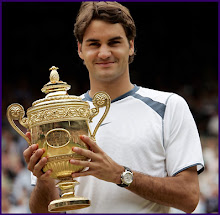Perfect balance, precise footwork, and an uncanny ability to watch the ball make Federer’s backhand a shot worth emulating.
It isn’t just that Roger Federer can masterfully hit any shot in the book—and a few shots that aren’t—but that he makes it look ridiculously easy. One of the keys to Federer’s success, and the principle reason his strokes look so effortless, is his extraordinary balance. Whether he’s hitting his huge forehand or his impressive backhand, he keeps his head and upper body remarkably quiet throughout the stroke.
1. Judging from his knee bend, you can tell that Federer is preparing for a low ball, perhaps an approach shot from his opponent. Even though he’s reacting quickly, he looks completely under control. He’s already changed his grip to one that’s slightly farther over from a classic Eastern. Also, notice the position of his racquet as he’s moving. Many players think you should prepare by immediately taking the racquet all the way back, but that’s not an efficient way to run. And while Federer’s shoulders have begun to turn, he won’t rotate them more until he plants his right foot.
2. Cradling the racquet in his left hand to control his backswing, Federer starts to turn his shoulders in unison with his racquet take-back. I like how his head is right in the center of his body. Pay attention to how he’s pointing his shoulder at the oncoming ball. This ensures good upper-body rotation, which is something many beginners and intermediates don’t do well. A full shoulder turn, along with a sound backhand grip, will help you drive the ball as well as avoid elbow problems.
3. This is a striking example of Federer’s excellent balance; he’s in the optimal position for this low ball. Even though he’s dragging his toe, he’s still got a lot of his weight on his left foot. Many players would have moved most of their weight onto their front foot at this point, which would cause their momentum to continue to the side after striking the ball and result in a more difficult recovery. Federer’s racquet is all the way back at this point and his shoulder turn is full, about 45 degrees to the baseline. His head, though, has barely moved from the previous photo.
4. Federer has just struck the ball and his left knee is almost touching the ground. His upper body remains still and balanced. This shot reminds me of how great downhill skiers allow their legs to go up and down like pistons but their upper bodies remain relatively quiet and straight up. Federer’s legs are doing all of the work of getting low to the ball; he’s not bending at the waist. It takes great core and quad strength to do this, but the payoff is that there’s no stress on the back. The angle between his arm and his racquet shows that he’s using a strong grip that will resist impact well.
5. Federer’s non-playing hand is back and down to counter balance his racquet hand going forward and up. Also, when the left arm goes back like that, it keeps the shoulders from turning and accelerates the right arm, giving you more power. As you can see, Federer’s shoulders are still sideways to the baseline. One common problem that players have with the backhand is that they pull up and open their shoulders so they almost face the net, losing power and control. Here, Federer’s head has hardly moved at all, and he has finished with his body perpendicular to the target.
6. Federer is recoiling after the swing,and it’s only now that he has started to look up and watch his shot. His body is still balanced, and because of that he won’t have to take an extra recovery step. If he were leaning over on such a wide shot, he would have to take one more step. One of the big differences between a good player and a great player is recovery, and you can’t recover well unless you have excellent balance. This is one reason Federer gets to so many balls.


No comments:
Post a Comment